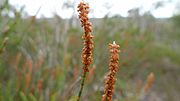| Dwarf she oak | |
|---|---|

| |
| Habit in the Blue Mountains | |
| Scientific classification | |
| Kingdom: | Plantae |
| Clade: | Tracheophytes |
| Clade: | Angiosperms |
| Clade: | Eudicots |
| Clade: | Rosids |
| Order: | Fagales |
| Family: | Casuarinaceae |
| Genus: | Allocasuarina |
| Species: | A. nana |
| Binomial name | |
| Allocasuarina nana (Sieber ex Spreng.) L.A.S.Johnson | |

| |
| Occurrence data from AVH | |
| Synonyms | |
|
Casuarina nana Sieber ex Spreng. | |
Allocasuarina nana, commonly known as dwarf she-oak or as stunted sheoak, is a species of flowering plant in the family Casuarinaceae and is endemic to south-eastern continental Australia. It is a low, spreading dioecious, rarely monoecious shrub that has branchlets up to 80 mm (3.1 in) long, the leaves reduced to scales in whorls of four to six, the fruiting cones 14–24 mm (0.55–0.94 in) long containing winged seeds 4–6 mm (0.16–0.24 in) long.
Description
Allocasuarina nana is a spreading, dioecious or rarely monoecious shrub that typically grows to a height of 0.2–2 m (7.9 in – 6 ft 6.7 in). Its branchlets are more or less erect, up to 80 mm (3.1 in) long, the leaves reduced to erect, scale-like teeth 0.5–0.6 mm (0.020–0.024 in) long, arranged in whorls of four to six around the branchlets. The sections of branchlet between the leaf whorls are 5–6 mm (0.20–0.24 in) long and 0.5–0.8 mm (0.020–0.031 in) wide. Male flowers are arranged in dense spikes 5–10 mm (0.20–0.39 in) long, with 16 to 20 whorls per centimetre (per 0.39 in.), the anthers 0.5–0.6 mm (0.020–0.024 in) long. Female cones are sessile or on a peduncle up to 3 mm (0.12 in) long, the mature cones cylindrical to barrel-shaped, 14–24 mm (0.55–0.94 in) long and 10–15 mm (0.39–0.59 in) in diameter, the winged seeds 4–6 mm (0.16–0.24 in) long.
Taxonomy
This she-oak was first described in 1826 by Kurt Polycarp Joachim Sprengel who gave it the name Casuarina nana in Systema Vegetabilium, from an unpublished description by Franz Sieber. In 1989 by Lawrie Johnson transferred the species to the genus Allocasuarina as A. nana in the Journal of the Adelaide Botanic Gardens. The specific epithet, (nana) means "dwarf".
Distribution and habitat
Allocasuarina nana grows in heath over sandstone in exposed places on the coast and tablelands of New South Wales south from Cowan and Glen Davis to the far north east of Victoria.
-
 Immature female cones
Immature female cones
-
 Male spikes
Male spikes
-
 Mature cones in Morton National Park
Mature cones in Morton National Park
References
- ^ "Allocasuarina nana". Australian Plant Census. Retrieved 28 June 2023.
- ^ Wilson, Karen L.; Johnson, Lawrence A.S. "Allocasuarina nana". Royal Botanic Garden Sydney. Retrieved 28 June 2023.
- ^ Entwisle, Timothy J.; Stajsic, Val. "Allocasuarina nana". Royal Botanic Gardens Victoria. Retrieved 28 June 2023.
- ^ "Allocasuarina nana". Australian Biological Resources Study, Department of Agriculture, Water and the Environment: Canberra. Retrieved 28 June 2023.
- Robinson, Les (2003). Field Guide to the Native Plants of Sydney (Revised 3rd ed.). East Roseville, N.S.W.: Kangaroo Press. p. 151. ISBN 978-0-7318-1211-0.
- "Casuarina nana". APNI. Retrieved 28 June 2023.
- Sprengel, Kurt P.J. (1826). Systema Vegetabilium. Vol. 3. p. 804. Retrieved 28 June 2023.
- "Allocasuarina nana". APNI. Retrieved 28 June 2023.
- Johnson, Lawrence A.S. (1982). "Notes on Casuarinaceae II". Journal of the Adelaide Botanic Gardens. 6 (1): 77. Retrieved 26 June 2023.
- William T. Stearn (1992). Botanical Latin. History, grammar, syntax, terminology and vocabulary (4th ed.). Portland, Oregon: Timber Press. p. 451.